The best firewood for a long-lasting, hot burn includes hardwoods like oak, maple, ash, and birch. These woods contain minimal pitch and sap, making them cleaner and more efficient for burning.
If you have some experience with burning firewood, you already know that every wood burns differently. Wood density and moisture level are the two key factors influencing the efficiency, hotness, and longevity of burning wood.
The finest woods burn efficiently and completely, leaving your fireplace and stove clean and mess-free. There’s another kind that doesn’t burn, fills your place with smoke, and causes havoc.
You must pick the best wood to burn in your fireplace to avoid such disasters. Here, we will talk about some of the best tree species that provide top-quality firewood so that you can ensure efficiency and safety.
A campsite doesn’t feel complete without a nice fire. With just a splitting axe or another appropriate, sharp tool, you can cut down green or standing dead wood, split it if necessary, and create a big stack of firewood for a fire. It keeps you safe and warm throughout the night, helps you dry moist or wet clothes, and allows you to prepare simple (or extravagant) delicious food to keep you going in the bush.
This article is about the best types of wood to burn outdoors. We’ll look at a few types of wood you’ll commonly find in North America and give you some tips, so you know how to choose and use the best wood in any situation.
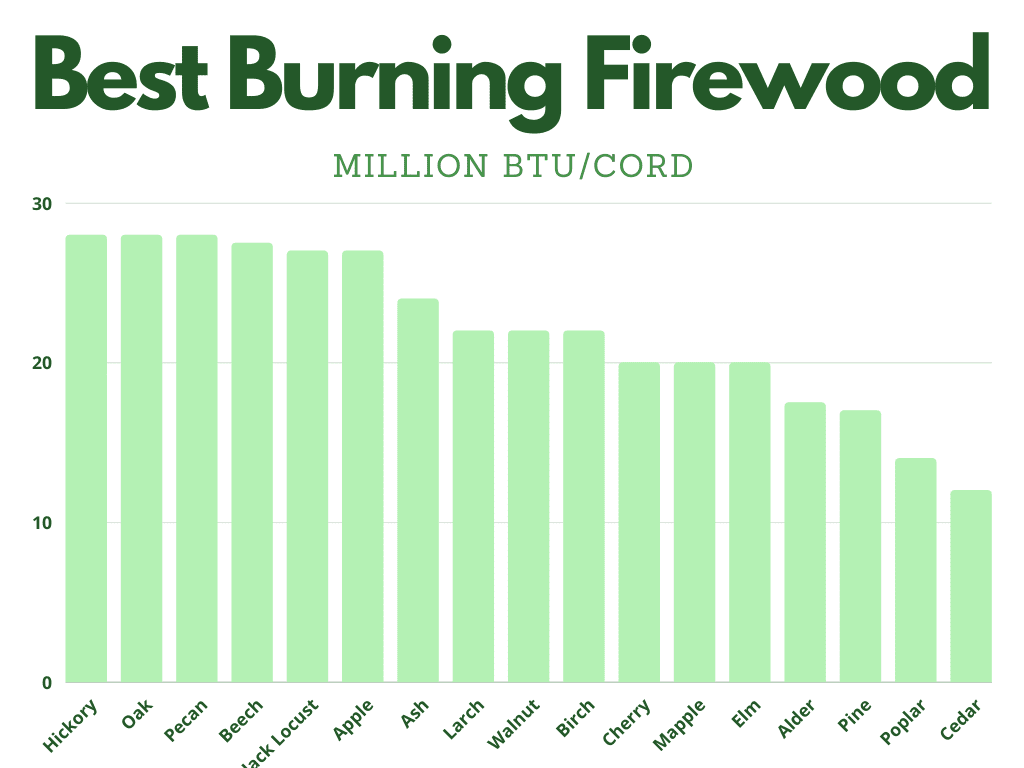
Table of Contents
Hardwood vs Softwood: Which Burns Better?
We can divide the firewood largely into two categories: hardwood and softwood. Both types have unique burning properties, making them suitable for different uses.
As hardwood comes from slow-growing deciduous trees, this type of wood is comparatively denser. The density of the wood decides the energy output of the firewood.
Denser hardwood has higher energy contents which produce more heat and less flame. Moreover, they will provide a steadier and longer burn time. Hardwood has the lowest sap and pitch, making it easier to burn with the least energy loss.
However, you might have a hard time lighting up the hardwood properly. Due to the high density of the hardwood, it takes more time to be seasoned. Hardwood is also pretty expensive, especially in the western areas of the US. It’s also difficult to clean up the stony coal bed left by the hardwood.
Despite its drawbacks, hardwood is the first choice of most people to burn in their wood stoves and fireplaces.
Typically, softwood is lighter and less dense than hardwood. Because of the low density, seasoning softwood takes only 6 to 12 months. Moreover, softwood is cheaper to buy and easier to kindle. It burns quickly and produces a hotter flame.
Softwood is perfect as scrap for lighting up the fire, so you can mix them with your hardwood stack to have better control over the fire you’re burning. Softwood can be valuable in spring or fall as it produces less intense heat.
Remember that the excessive use of softwood can build up creosote inside your chimney and cause a fire.
1. Oak
Since there are plenty of oak trees around the United States, this is the most popular firewood among the natives. Oakwood has a density of 37-56 lbs./ft.3, which is high enough to keep your place warm for the whole night. This hardwood is known for its slow burns and clean residues.
Each cord of oakwood produces 24-28 million BTUs – making the burns hotter than most other types of firewood. One drawback of the wood is that it takes almost 2 years to completely dry. Apart from that, oak is the ideal firewood to burn.
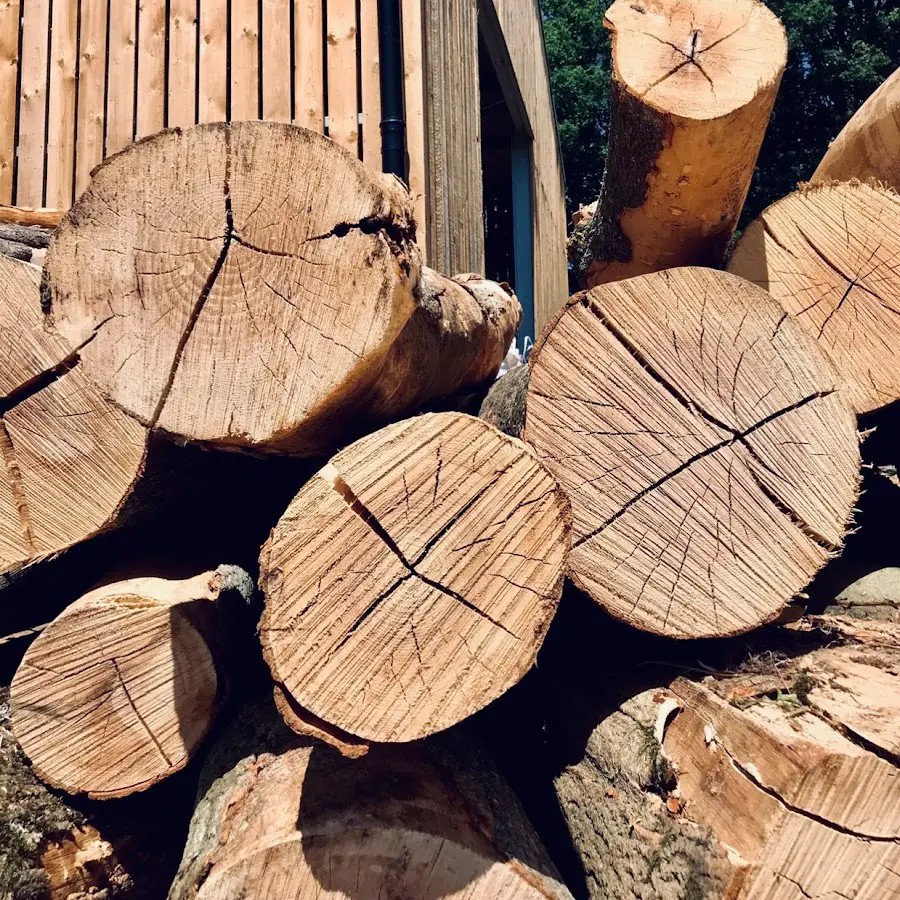
2. Hickory
Hickory is another high-quality firewood with an impressive heat production of 28.5 million BTUs for each cord. It is also one of the brightest and longest burning woods that usually burns for more than four hours.
The wood leaves thick hot coal to warm your room till the morning. With its 37-58 lbs./ft.3 dense logs, the wood will burn clean and create the least amount of smoke.
3. Birch
This native hardwood has two excellent features that make it many people’s first choice. Despite being a hardwood, it takes a surprisingly short time to be completely dried out. Also, some types of birch wood can be used without seasoning.
The wood produces 20.8 million BTUs per cord, even for the coldest nights. Moreover, birch is considered the best smelling firewood by many people. It has a subtle and sweet aroma that will elevate your mood instantly.
Birch is a wood that burns well and gives off good heat, but at the cost of burn time – this is not a slow-burning wood! It will burn green, however, and light up with ease, so it’s a great choice of firewood when hiking a trail in the bush. Its papery bark is also great for starting fires; it lights easily and can jumpstart kindling.
4. Ash
Ash is historically widespread throughout central and eastern North America, and even green burns well. That makes it a great wood for burning when camping, bushcrafting, or hiking – if you can find it. It burns fast, though, so you’ll have to either find a lot of it or mix it in with some slower-burning wood such as oak, walnut, maple, hawthorn, or hickory.
Unfortunately, North American ash is threatened by an invasive beetle species (emerald ash borer) that it has no resistance to. As a result, ash numbers are declining throughout the North American continent. If you see an ash tree with large round holes in its bark, you know the EAB beetle has attacked it. In this case, it’s almost certain that the tree is a goner and can be cut down and burned.
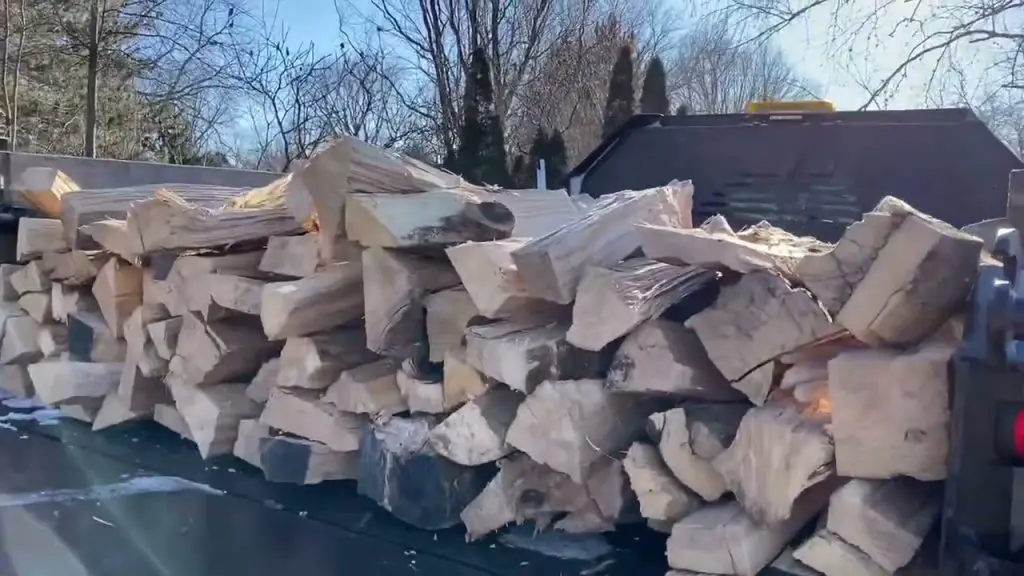
5. Cedar
Let’s talk about some of the softwood options.
As every cord of cedarwood produces 12-13 million BTUs heat, the wood is most suitable for the initial days of winter. Cedarwood creates less flame and more heat that lasts longer than other softwood.
It also has a pleasant smell that fills up your living spaces or campsites. Keep in mind that cedar is one of the most expensive softwoods.
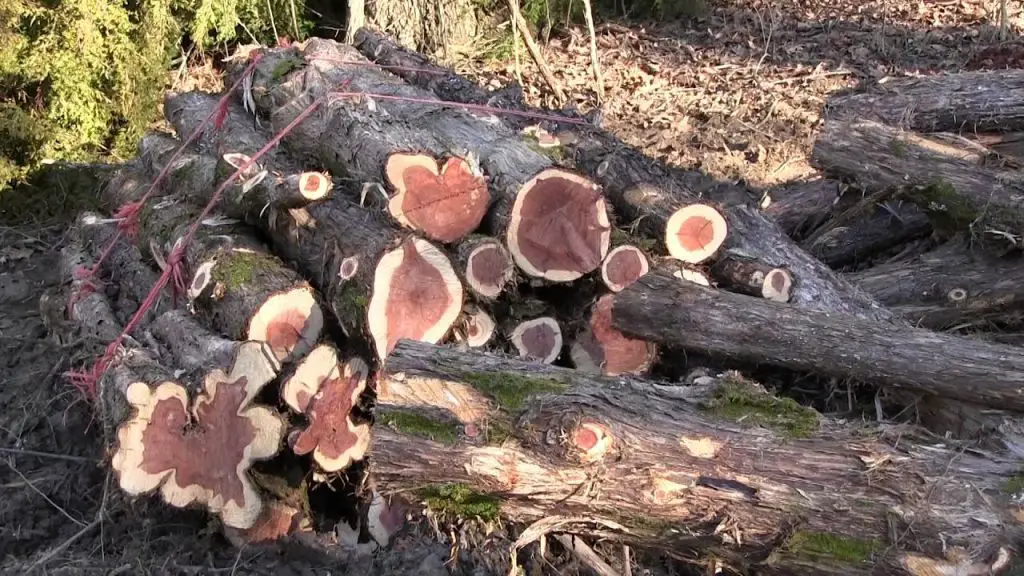
6. Larch
Larch is considered the hardest softwood, and it has many properties of most hardwoods. As the wood is denser, it provides a long-lasting burn time. It creates hotter flames with less smoke. The wood also has an impressive 21.8 million BTUs heat production for each cord.
7. Pine
Pinewoods come from a wide variety of pine trees, each with unique burning properties. Most pinewoods produce 15-21 million BTUs per cord. You can light up this softwood quickly and use it to fuel a campsite fire. Pinewood is easily attainable and comes at very affordable prices. However, if you use pine to heat your home in winter, you will need to store more compared to higher BTU alternatives.
You’ll find pines growing all over North America. As such, pine is a plentiful resource for campers and hikers to use in their fires. The one great thing about pine is that it lights up fast and burns well. That is due to the pine resin it contains. It’ll go up in flames fast, even in wet weather, due to the extremely flammable nature of the resin.
The major drawback of pine is that it is terrible for cooking on – the resin goes up in the smoke, makes it black, sticks to food and changes the taste – and is very unhealthy for you. If you’re going to be cooking, try to use as little pine wood as possible. If pine is all you have, let it burn up as much as possible before cooking on it.
One thing that pine is also great for is that it is wonderful at starting fire – use a bit of pine bark, resin, and fatwood (pine wood with a lot of sap in it) to create an excellent firestarter for other types of wood that you have.
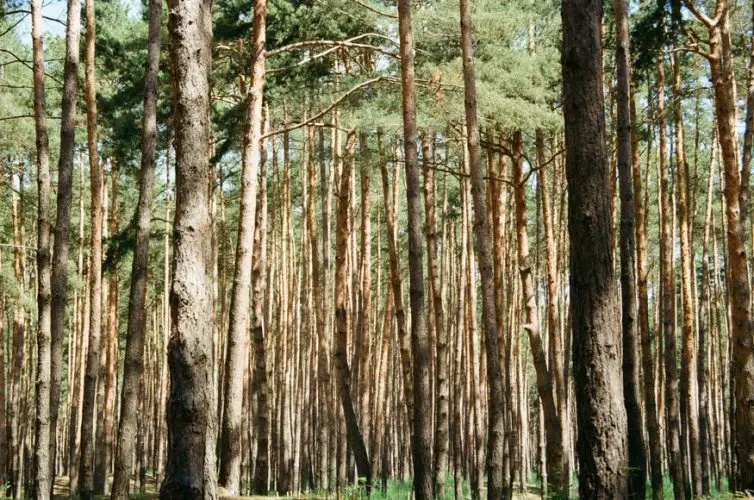
Other Firewood
If you come across fallen maple, walnut or other hardwoods, don’t hesitate to add them to your campfire if the wood isn’t wet and rotten. Hawthorn contains little moisture and gives off great heat. Of course, it is preferable to burn dry wood that has seasoned for at least 8 to 9 months (softwoods) or a year and more (hardwoods).
In a survival situation, of course, using such seasoned wood might not be possible, so you’ll have to make do with what you come across. All the above-mentioned woods burn well and will provide you with a good fire, as long as you know how to use them in a fire. You won’t be able to get a good fire going out of green oak alone, but if you combine pine, birch, and oak, you’ll be able to get a crackling fire going in a short time and then stretch it out throughout the night if you thrown a piece of green hardwood (the oak) into it.
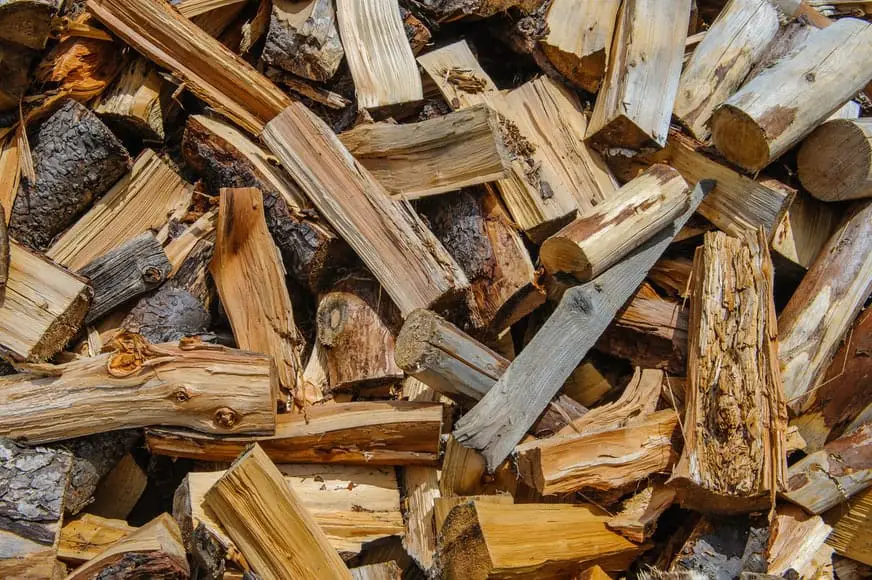
Which Firewood Burns the Hottest
The heat production is measured in British Thermal Units or BTUs. The higher the BTU value, the more heat the wood will produce.
The hottest burning firewood is Osage Orange with a heat production of 32 million BTU/cord, followed by Hickory and Oak with 28 million BTU/cord.
Forestry experts of Utah State University have ranked the most common firewood according to their BTUs value.
Firewood BTU Chart
Here are the wood density and heat values of some selected species in an easy-to-use firewood BTU chart:
| Type of Firewood | Hardwood or Softwood | Wood Density (lbs/ft3) | Heat Production (million BTUs/cord) | Smoke Produced |
| Osage Orange | Hardwood | 53 | 32 | High |
| Hickory | Hardwood | 37-58 | 28 | Minimal |
| Oak | Hardwood | 37-56 | 28 | Minimal |
| Pecan | Hardwood | 45 | 28 | Moderate |
| Mesquite | Hardwood | 40 | 28 | Moderate |
| Beech | Hardwood | 37 | 27.5 | Minimal |
| Olive | Hardwood | 64 | 27 | High |
| Black Locust | Hardwood | 48 | 27 | Minimal |
| Apple | Hardwood | 41-52 | 27 | Minimal |
| Yew | Hardwood | 45 | 27 | Minimal |
| Almond | Hardwood | 69 | 27 | Minimal |
| Honey Locust | Hardwood | 46 | 26.7 | Minimal |
| Mulberry | Hardwood | 47 | 26 | Moderate |
| Pear | Hardwood | 55 | 26 | Minimal |
| Ash | Hardwood | 40-53 | 24 | Minimal |
| Larch | Softwood | 31-35 | 22 | Minimal |
| Juniper | Softwood | 35 | 22 | Moderate |
| Black Walnut | Hardwood | 32 | 22 | Minimal |
| Birch | Hardwood | 42 | 21 | Moderate |
| Douglas Fir | Softwood | 33 | 21 | High |
| Cherry | Hardwood | 43-56 | 20 | Minimal |
| Maple | Hardwood | 39-47 | 20 | Minimal |
| Sycamore | Hardwood | 50 | 20 | Moderate |
| Elm | Soft Hardwood | 35 | 20 | Moderate |
| Chestnut | Hardwood | 46 | 18 | Moderate |
| Aspen | Soft Hardwood | 21 | 18 | Low |
| Alder | Hardwood | 25 | 17.5 | Low |
| Pine | Softwood | 22-31 | 17 | High |
| Cottonwood | Soft Hardwood | 46 | 16 | Moderate |
| Spruce | Softwood | 28 | 15 | Moderate |
| Poplar | Hardwood | 22-31 | 14 | Moderate |
| Cedar | Softwood | 23 | 12 | Moderate |
Conclusion
Well, now you know the best firewood to burn this winter. High-quality firewood is essential for ensuring optimal heat and safety. Woods with high density and heat values are most suitable for indoor and outdoor usage.
Of the two main types, hardwood will provide you with the longest burning sessions and the highest heat, whereas softwood will instantly light up and burn with hotter flames. Try to stack both hardwood and softwood to fill those chilly nights with warmth and comfort. Another aspect to consider is the cost of firewood, which can vary widely depending on availability.
Hopefully, this article helped – please share your wood preferences in the comments below! It’s always good to hear and exchange personal experiences and thoughts regarding survival and comfort in difficult situations. Thanks for reading!
